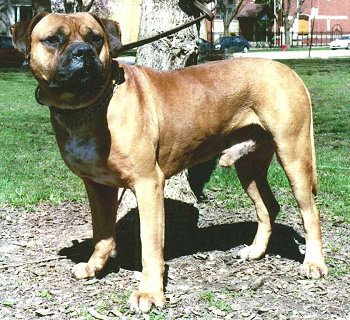Alano Espanol (Dog Breed)
As the name suggests, the Alano Espanol is Spanish by origin and is also known as the Spanish Bulldog. These dogs are very large, belonging to the molosser type of dogs. This means that these dogs belong to the group of dogs that originated from ancient Greece, from a shepherd dog breed called Molossus.
These dogs have large, strong heads. Males should not be smaller than 24 inches and should weigh about 38-45 kg. Females are usually somewhat smaller in size and lighter. These dogs have short, thick coats and are commonly found in brindles of blue, gray, red or bayo. White patches are found sometimes but are not common. Their faces may or may not have a black mask. These dogs have short muzzles and a slightly concave lower jaw. The nose is very large, broad and usually black in color. Their ears are high set and may either be cut short or may even drop. The skin is typically very thick and folds and wrinkles are commonly found on the face and in the neck and shoulder areas.
The breed takes it name from the Alani tribes. These people were pastoral nomads who kept large flocks of livestock and hence had to depend on guard dogs to protect them. The earliest reference to these dogs dates as far back as the 14th century. These dogs are also known to have journeyed with the Spanish explorers and were often used to subjugate native people and enslave them. A very similar type of dog can be found on the coat of arms of the Canary Islands. These dogs were also used in popular sports such a bull-baiting and of course, hunting big game.
As the nature of the work given to these dogs began to change, so did the breed itself. In fact, by 1963, these dogs were supposed to have become extinct. They were rediscovered in northern Spain by a group of veterinary students and dogs enthusiasts in 1970s. They found that these dogs were still being used to herd cattle and also to hunt. In 2004, the Spanish Kennel Club recognized these dogs as a separate breed. The Alano Espanol is now generally recognized as an indigenous breed by the Spanish Agriculture Ministry. These dogs are prone to health concerns that arise from inbreeding. This is because the breed was restored using a small number of dogs. All dogs of this breed should be checked for hip dysplasia.
As the name suggests, the Alano Espanol is Spanish by origin and is also known as the Spanish Bulldog. These dogs are very large, belonging to the molosser type of dogs. This means that these dogs belong to the group of dogs that originated from ancient Greece, from a shepherd dog breed called Molossus.
These dogs have large, strong heads. Males should not be smaller than 24 inches and should weigh about 38-45 kg. Females are usually somewhat smaller in size and lighter. These dogs have short, thick coats and are commonly found in brindles of blue, gray, red or bayo. White patches are found sometimes but are not common. Their faces may or may not have a black mask. These dogs have short muzzles and a slightly concave lower jaw. The nose is very large, broad and usually black in color. Their ears are high set and may either be cut short or may even drop. The skin is typically very thick and folds and wrinkles are commonly found on the face and in the neck and shoulder areas.
The breed takes it name from the Alani tribes. These people were pastoral nomads who kept large flocks of livestock and hence had to depend on guard dogs to protect them. The earliest reference to these dogs dates as far back as the 14th century. These dogs are also known to have journeyed with the Spanish explorers and were often used to subjugate native people and enslave them. A very similar type of dog can be found on the coat of arms of the Canary Islands. These dogs were also used in popular sports such a bull-baiting and of course, hunting big game.
As the nature of the work given to these dogs began to change, so did the breed itself. In fact, by 1963, these dogs were supposed to have become extinct. They were rediscovered in northern Spain by a group of veterinary students and dogs enthusiasts in 1970s. They found that these dogs were still being used to herd cattle and also to hunt. In 2004, the Spanish Kennel Club recognized these dogs as a separate breed. The Alano Espanol is now generally recognized as an indigenous breed by the Spanish Agriculture Ministry. These dogs are prone to health concerns that arise from inbreeding. This is because the breed was restored using a small number of dogs. All dogs of this breed should be checked for hip dysplasia.
 |
| Alano Espanol |
 |
| Alano Espanol |
 |
| Alano Espanol |
 |
| Alano Espanol |
 |
| Alano Espanol |
 |
| Alano Espanol |
 |
| Alano Espanol |
 |
| Alano Espanol |
 |
| Alano Espanol |
 |
| Alano Espanol |
ohhh soo cute
ReplyDelete